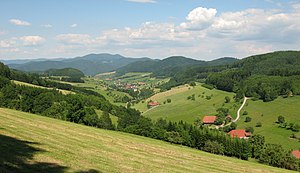Wikipedia:WikiProject Germany/Portal:Baden-Württemberg
Introduction

Baden-Württemberg (/ˌbɑːdən ˈvɜːrtəmbɜːrɡ/ BAH-dən VURT-əm-burg; German: [ˌbaːdn̩ ˈvʏʁtəmbɛʁk] ), commonly shortened to BW or BaWü, is a German state (Land) in Southwest Germany, east of the Rhine, which forms the southern part of Germany's western border with France. With more than 11.07 million inhabitants as of 2019[update] across a total area of nearly 35,752 km2 (13,804 sq mi), it is the third-largest German state by both area (behind Bavaria and Lower Saxony) and population (behind North Rhine-Westphalia and Bavaria). As a federated state, Baden-Württemberg is a partly-sovereign parliamentary republic. The largest city in Baden-Württemberg is the state capital of Stuttgart, followed by Mannheim and Karlsruhe. Other major cities are Freiburg im Breisgau, Heidelberg, Heilbronn, Pforzheim, Reutlingen, Tübingen, and Ulm.
What is now Baden-Württemberg was formerly the historical territories of Baden, Prussian Hohenzollern, and Württemberg. Baden-Württemberg became a state of West Germany in April 1952 through the merger of South Baden, Württemberg-Baden, and Württemberg-Hohenzollern. These three states had been artificially created by the Allies after World War II out of the existing traditional states by their separation over different occupation zones.
Baden-Württemberg is especially known for its strong economy with various industries like car manufacturing, electrical engineering, mechanical engineering, the service sector, and more. It has the third-highest gross regional product (GRP) in Germany. Part of the Four Motors for Europe and located in the Blue Banana, some of the largest German companies are headquartered in Baden-Württemberg, including Mercedes-Benz Group, Schwarz Group, Porsche, Bosch and SAP.
The sobriquet Ländle, a diminutive of the word Land in the local Swabian, Alemannic and Franconian dialects, is sometimes used as a synonym for Baden-Württemberg. (Full article...)
Selected article

Heart of Stone (German: Das kalte Herz, literally "The Cold Heart") is a fairy tale written by Wilhelm Hauff. It was published in 1827 in a collection of fairy tales that take place within the narrative of The Spessart Inn. It formed the basis for the East German film Heart of Stone, released in 1950.
Connections of this tale to the Romantic Era can be drawn. During this literary period it was quite common to write prose in fairy tale form. Drawing on the myth of the "glass-imp", Hauff presents the Romantic pursuit of happiness. Other Romantic characteristics include the use of the mystical-eerie, the uncanny and folk tales.
The key concept of Romanticism is the longing (Sehnsucht) that Coal-marmot Peter embodies, as he is granted three wishes throughout the story. What results from this longing is, as often seen in protagonists of Romantic works, self-destruction, since the riches Peter wished for crumble into misery and his longing degenerates into stinginess and spite. As the hopeless romantic that he is, Coal-marmot Peter does not give up on his quest for happiness and at the end of the fairy tale eventually finds this happiness with his wife.
Selected biography

Eduard Friedrich Mörike (8 September 1804 – 4 June 1875) was a German Romantic poet and writer of novellas and novels. Mörike was born in Ludwigsburg. His father was Karl Friedrich Mörike (died 1817), a district medical councilor; his mother was Charlotte Bayer. After the death of his father, in 1817, he went to live with his uncle Eberhard Friedrich Georgii in Stuttgart, who intended his nephew to become a clergyman. Therefore, after one year at the Stuttgart Gymnasium illustre, Mörike joined the Evangelical Seminary Urach, a humanist grammar school, in 1818 and from 1822 to 1826 attended the Tübinger Stift. There, he scored low grades and failed the admission test to Urach Seminary, yet was accepted anyhow. At the Seminary he went on to study the classics, something that was to become a major influence on his writing, and he made the acquaintance of Wilhelm Hartlaub and Wilhelm Waiblinger.
State facts
- Nickname: Ländle
- Capital: Stuttgart
- Minister-president: Winfried Kretschmann
- Governing parties: Greens / CDU
- Total area: 35,751 km2 (13,804 sq mi)
- Population: 10,879,618 (2015)
- Founded: April 25, 1952
- Website: www.baden-wuerttemberg.de
Selected image
Did you know?

- ...that Spaghettieis was created by Dario Fontanella in the late 1960s in Mannheim? Although it is not well known outside Germany, it can be found at some gelaterias and specialty ice cream parlors, at special events and at some hotels and restaurants around the world.
- ...that the world's first filling station was the city pharmacy in Wiesloch, where Bertha Benz refilled the tank of the first automobile on its maiden trip from Mannheim to Pforzheim and back in 1888. Since 2008 the Bertha Benz Memorial Route commemorates this event.
Subcategories
Selected panorama
 |
The New Palace (German: Neues Schloss) is an 18th century Baroque palace and is one of the last large city palaces built in Southern Germany. The palace is located in the center of Stuttgart on the Schlossplatz in front of the Jubiläumssäule column and Königsbau. Public tours of the building are only permitted by special arrangement, as the building contains some government offices.
Topics
Related portals
Associated Wikimedia
The following Wikimedia Foundation sister projects provide more on this subject:
-
Commons
Free media repository -
Wikibooks
Free textbooks and manuals -
Wikidata
Free knowledge base -
Wikinews
Free-content news -
Wikiquote
Collection of quotations -
Wikisource
Free-content library -
Wikiversity
Free learning tools -
Wikivoyage
Free travel guide -
Wiktionary
Dictionary and thesaurus
















